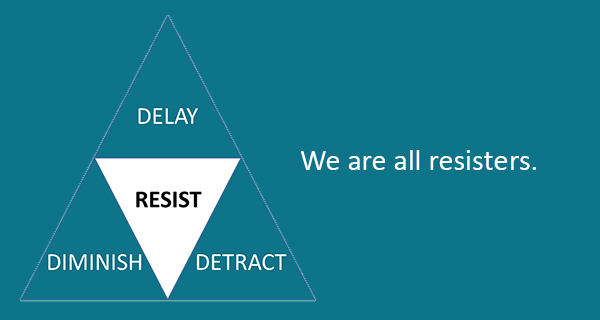Delay, Diminish and Detract – the three D’s of change resistance – and 5 things you can do for better results.
by Jerry Timpson
 I am a change resister. I admit it. I don’t like change so much because something bad could happen. And the only way you’re not one too is if you are not a human being.
I am a change resister. I admit it. I don’t like change so much because something bad could happen. And the only way you’re not one too is if you are not a human being.
When I was just starting as a change agent, someone asked me asked me why people were so change resistant. I remember thinking I should have had a better answer than, “Yes, that’s a problem.” But I was early-on in my own journey and tactics were more top of mind than root causes. Over the years though, that question has stayed with me and I’ve thought a lot about it since then. Fundamentally, change resistance has to do with our need for survival. We fear the uncertainty that change has the potential to bring – especially when it’s coming from outside of our own control and it hasn’t been made clear how it’s going to directly impact us… and by “us” I mean: Me.
When it comes to trying new and different things, there’s usually not so much consideration for the greater good. Resistance is natural and it’s always personal. It happens at all levels up and down the organization. No one is immune from worrying about their own future. So if you want to diminish resistance; reduce the unknowns. It also helps to recognize different forms that change resistance so that we can, well… resist them.
Delay – Wait It Out
Add as much time as humanly possible between first finding out about a change and then actually doing something different. This effective technique is also known as “Wait it out.” Delay tactics include:
- Declare ignorance: “Change??? What change???”
- Seek more information through analytics
- Require clarification – which is a great set up for debate, negotiation and more delay.
It’s often difficult to tell if the delay tactics are to avoid the change or if they are really valid since many change initiatives are poorly communicated and under-planned.
Diminish – Side Step
Make the change smaller and less impactful by doing something for appearances, but in reality as little as possible. This could mean doing things the same way as always with really minor tweaks and avoiding detection for as long as possible. Or it could be filling any gaps with one’s own version of what doing it looks like. This is where a well-developed implementation and communication plan can help. Diminish makes it seem like something is happening when really a lot of stepping from side to side is going on.
Detract – Covert Operations
Tear it down by attacking from the inside. Probably the most insidious, this is where resistance is most covert. People talk. The resistance gathers in lunch rooms and around the now mostly virtual water cooler, and discusses how terrible and rotten the change is. Pretty soon (the very next day) there is a network of confederates who work hard – whether they know it or not – to demolish the change and stick with what is more familiar. Or, small changes start to occur but not without some problems. Instead of finding workable solutions, detractors magnify the problems and point out the flaws.
5 Things You Can Do For Better Results
All of the above might sound like an attack on the Change Resisters of the world. It’s not. I respect the resistors and I am a proud member of that club. After all, for an enlightened organization, resistance is a good way to discover better solutions. Since we know resistance is natural and always part of any change, we focus our critique on the design and execution of the change. *It’s worth pointing out that over half all all projects fail in the first round (*Source: The internet)
When change fails, it’s either because the idea was truly bad at the start or the execution was flawed. Since even a bad idea can be evolved to success (you know, “fail fast” and all that), we’re sticking with flawed execution as the number one reason for failure. To avoid the pain and suffering visited upon the entire organization from poor design and execution, do these 5 things to mitigate the unknowns:
- Make an implementation plan. Go beyond organization charts and dig into the processes with the people who do them. Figure out the what, when, who, how and how much.
- Communicate carefully, then over-communicate… by a factor of 10. Listen intensely. Respond accordingly. Make a communications plan and stick to it. It’s impossible to communicate too much when you’re trying to manage a change process.
- Have answers. Think through the questions you will get. If you don’t know something; say so. You’ve got to be credible when asking someone to change their ways.
- Engage broadly. Involving people in the design is great – but engagement should intensify as implementation ramps up. This is where real problems can only be solved by those doing the work.
- Market success. Capture successes along the way and make it a big deal. Include these moments front and center in your communication plan and one-on-one conversations.
Hopefully you’ll see some trends here and can apply some of these simple ideas. If you want to share stories and find out more about Kaufman Global solutions, please don’t hesitate to contact us.

Jerry Timpson is the co-founder and President of Kaufman Global. He’s a top rated change agent with focus on implementation, leadership alignment and employee engagement. You can connect with Jerry on LinkedIn.


